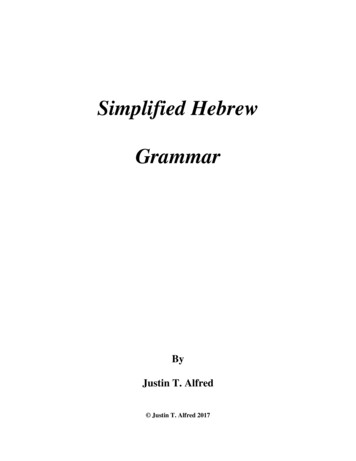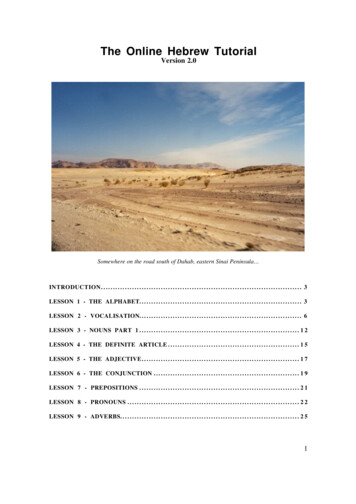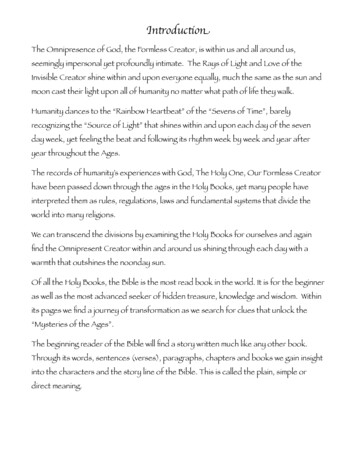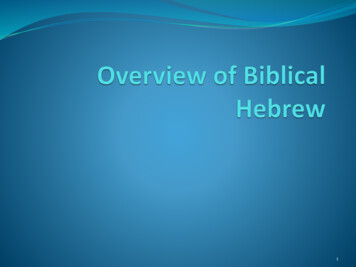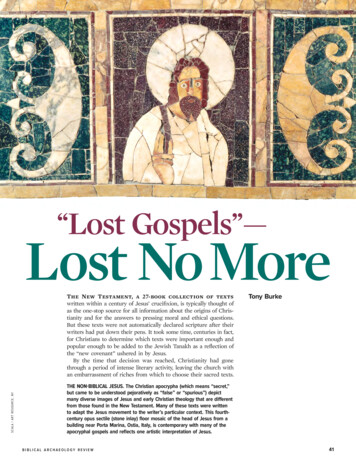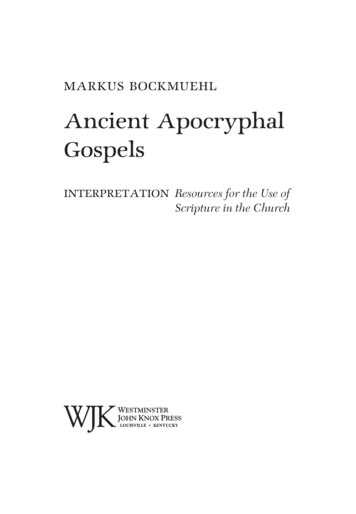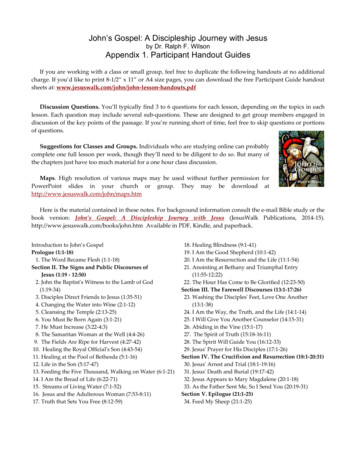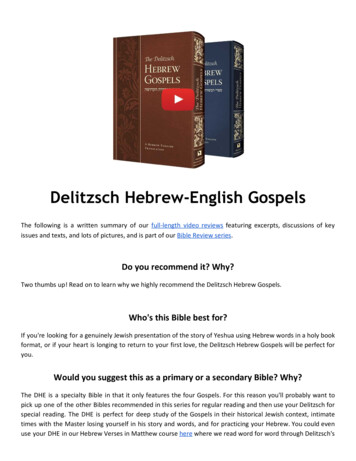
Transcription
Delitzsch Hebrew-English GospelsThe following is a written summary of our full-length video reviews featuring excerpts, discussions of keyissues and texts, and lots of pictures, and is part of our Bible Review series .Do you recommend it? Why?Two thumbs up! Read on to learn why we highly recommend the Delitzsch Hebrew Gospels.Who's this Bible best for?If you're looking for a genuinely Jewish presentation of the story of Yeshua using Hebrew words in a holy bookformat, or if your heart is longing to return to your first love, the Delitzsch Hebrew Gospels will be perfect foryou.Would you suggest this as a primary or a secondary Bible? Why?The DHE is a specialty Bible in that it only features the four Gospels. For this reason you'll probably want topick up one of the other Bibles recommended in this series for regular reading and then use your Delitzsch forspecial reading. The DHE is perfect for deep study of the Gospels in their historical Jewish context, intimatetimes with the Master losing yourself in his story and words, and for practicing your Hebrew. You could evenuse your DHE in our Hebrew Verses in Matthew course here where we read word for word through Delitzsch's
translation of Matthew!At first glance you may be disappointed that this beautiful book is limited to the storyof Yeshua as told in the four Gospels and that a translation of the entire NewTestament isn't forthcoming. Upon closer inspection though, this limitation is actuallyone of the DHE's greatest strengths. It's an invitation to return to your first love, torenew that "pure and simple devotion" that Paul spoke of, to plant yourself at thedusty feet of your Rabbi and choose the "one thing necessary" that can never betaken from you. Handled right, your DHE can make you more Christ-centered thanyou even thought possible.In discussing the backstory to this version the publishers explain that this focus is indeed one of their chiefobjectives. Not only to publish the most Jewish presentation of the Gospels today or to encourage intensivestudy by pulling these four books out and elevating them as a superior text, but to give you a personalexperience of "hitkashrut" or "intense connection". In Jewish spirituality reading the words of a sage istantamount to being in his very presence. Similarly, as the repository of the precious words of our holyTeacher, these Gospels are our closest connection to Him.How's this version's relationship with the Jews and Judaism?In the beginning, the story of the Jewish Messiah was foreign to Gentile ears. Ironically, two thousand yearslater Christianity has drifted so far from her roots that Jewish people now see the message of Christ as adifferent religion and therefore irrelevant. The DHE changes all that. The Publishers in their preface announcetheir intent to give the Gospels back to the Jewish world by "returning the words and deeds of Yeshua back toa Jewish milieu by restoring the Gospels to their original Semitic voice, thereby allowing our brothers andsisters to consider his words and glean from his teachings without hindrance."This becomes apparent from themoment you pick this Bible up. It opensfrom right to left like a classic Jewish"sefer" or holy book. In keeping with theJewish tradition of beautifying the Torahits aesthetics from cover to layout tofont are nothing shy of intoxicating. TheIntroduction summarizes the life ofRabbi Yeshua and shows how he can beseen both as the suffering "MashiachBen Yosef" and as the conquering"Mashiach Ben David" and then leads inthe traditional Jewish prayers that are
said before the study of Scripture. Each Gospel is prefaced by a page explaining its history and uniquecharacter, anthologized from the writings of traditional Rabbis who became disciples. Moving on to the actualGospels, on the right-hand page lies a Hebrew text of the Gospels and to the left, an English translationhonouring the original Hebrew names of people and places and using many Hebrew keywords familiar to allJewish people.The Jewishness of the Delitzsch Hebrew Gospels isn't merely skin deep, nor is it a mask donned bymissionaries to trick Jews into becoming Christians. The team behind this book's production are MessianicJews and non-Jews living inside and outside the land of Israel who practice Judaism with their families, areimmersed in traditional Jewish texts, and demonstrate great respect for historical Judaism. Executive ProducerBoaz Michael and Chief Translator Aaron Eby both point out that throughout the Gospels Yeshua and hisdisciples are seen participating in the Judaism of their time - attending synagogue and worshipping at theTemple, debating hot topics and discussing local news, and challenging their fellow-Jews on how theypracticed their common religion. They also point out that as "some of the oldest written Jewish literature thatwe have" the Gospels are a historical repository of Jewish oral traditions which weren't otherwise recordeduntil centuries later. Customs such as reading the Haftarah, naming a son on the 8th day, saying a blessingbefore eating, celebrating a Seder with cups of wine and Hallel singing, and the centrality of the Shema, allmake their debut in the first-century story of the Rabbi from Nazareth.Of course there can be a downside toall this. The Translators acknowledge,"Many English translations focus onmaking Yeshua seem more culturallyrelevant and familiar, but this approachcan obscure his true national andcultural identity. We want people torealize they're reading stories aboutJews living in Israel rather than pastorsliving down the street. We want totransfer people back into the context ofthe Scriptures." What that means is if Hebrew is all Greek to you or you somehow missed that Judaism 101class back in school, the world of the DHE may feel foreign to you. For the first time in your life Jesus may evenseem distant. It's frustrating trying to read a story and getting hung up on new words and unpronounceablenames. This can be especially not fun if you thought that you already knew the New Testament and therewasn't much more to learn. If that's you our encouragement is to "become like a child" and open yourself upto learning some new things. Keep your eyes on Jesus and remember that it's all about "knowing Jesusbetter", as the publishers often emphasize. So slow down, listen to the story of Yeshua as if for the first time,and allow yourself to see him through new eyes. And finally, let this sink in - you know that disconnect you'reexperiencing right now as a Gentile having the Gospels presented to you in a Jewish way? That's exactly howthe Jewish people have felt for centuries when the Gospel was presented to them in a Gentile way!
Who's the publisher and when did it come out?Professor Franz Delitzsch's Hebrew translation of the New Testament was first released by the British ForeignBible Society in 1877 and, 11 revisions later, was published in its final form in 1890. Over a century later theDelitzsch Hebrew Gospels was released in 2011 by Vine of David, "A publishing arm of the ministry of FirstFruits of Zion dedicated to providing liturgical resources for the Messianic Jewish movement and toresurrecting the voices of Messianic pioneers and luminaries." The staff at Holy Language Institute informallyrefer to FFOZ as our "ministry crush" and we highly recommend their resources which can be found atwww.ffoz.org and www.vineofdavid.org .VOD's stated mission is to "Reveal Yeshua as the light to the nations and asthe hope and glory of his people Israel" and the DHE is dedicated to FranzDelitzsch "For his love for the Jewish people and the Jewish context ofScripture, which came at great personal sacrifice. He stood firm in an erawhen the majority of Christian scholars were moving ever further away fromJewish interpretation and progressing toward the hate and ignorance thatculminated in the Holocaust. May we in a small way be able to carry on his work and vision." Read on to seewhy VOD's aim would have resonated so deeply with Franz Delitzsch and how the DHE truly is a testament tothe legacy of this great Bible scholar.Who translated it and what's their story?The Hebrew translation was the masterpiece of Professor Franz Delitzsch who wasa Christian theologian, Hebrew scholar, and friend of the Jewish people who livedin Germany in the 1800s. For his full story watch the video reviews .The English translation was mainly done by Aaron Eby, who is the Director of Vineof David and part of the teaching team at First Fruits of Zion. Aaron lives in theMinneapolis-Saint Paul area and is actively involved with Beth Immanuel, atraditional Messianic synagogue. Aaron has been working for years to developliturgical resources that will strengthen Messianic Judaism, with the DHE being justone of his projects.The tireless work and passionate scholarship of Franz Delitzsch continue to touchthe lives of Jews and Gentiles, individuals and congregations, a full century after hisdeath. We believe the same will be said of Aaron Eby and that what we've seenthus far is but a firstfruits of the degree to which his brilliant mind and chasidicdevotion will shape the Messianic Jewish world of the future.
Is it more word for word or thought for thought?The Hebrew and the English translations are both very literal. In his Hebrew translation of the New Testament,Franz Delitzsch sought to accurately represent the Greek text while at the same time reconstructing theoriginal Hebrew words and thought patterns of Yeshua and his disciples. He wrote, "The principle which Ifollowed in my translation was to render the New Testament into Hebrew of such a kind as the sacred writerswould themselves have employed." Accordingly, while the structure is Biblically styled Hebrew, the contentincludes a sprinkling of Mishnaic Hebrew terms and even the occasional Greek loanword which weren't usedin the Old Testament but were used in Jewish literature from the New Testament era and thus would havebeen recognizable to the authors of the Gospels. He explained, "And there too I laid down the principle thatthe translation should not avoid rabbinical expressions, if they supply the words and formulae in which,without undue straining, the New Testament Greek can be made intelligible to those who employ thepost-biblical literature."The notion of Jesus and his apostles speaking Hebrew instead of Aramaic or even Greek may startle somepeople, but this was the belief of the learned Franz Delitzsch over a century ago who pointed out that"Hebrew remained, even after the exile, the language of Jewish literature" and asserted that "the Shemiticwoof of the New Testament is Hebrew, not Aramaic. Our Lord and his apostles thought and spoke for the mostpart in Hebrew." Since then more evidence has come forth to support the professor's conclusion that, whileAramaic was used in Second-Temple Israel, Hebrew was also spoken as a living language and that there wasconsiderable overlap between the two. For a more detailed discussion of this topic along with an overview ofthe available evidence please see the "Hebrew History" section of our Hebrew Quest course.In keeping with Delitzsch's attempts to reconstruct the original language of the Jesus narratives and draw thereader into the story - versus serving the story to the reader on a culturally eviscerated silver platter - theEnglish translation follows the syntax of the Hebrew as closely as possible. This parallelism is one of thegreatest strengths of the DHE and is especially useful if you're reading verse by verse through the Hebrew andconsulting the English when unsure of a word or phrase.Reflecting the underlying Hebrew sentence structure is just one way the English translation is very literal.Another way is how it handles idioms, which the publishers describe as "clumsy phrases that don't transferproperly or that mean something beyond their literal reading". The DHE is "fairly wooden in preserving theHebrew idioms" while at the same time explaining their meanings in the glossary.For a more in-depth discussion of the translation philosophy behind the DHE and a personal example of howthe parallelism of the DHE made it perfect for our Director to read with his daughter, watch the video reviews .
Does it also have the Hebrew text?It's obvious by now that the DHE features a Hebrew text so this question may seem superfluous, but we choseto include it from the standard "20 questions" we ask in this Bible Review series as a segue to further discussthe Hebrew text. We tell the story of Professor Delitzsch's translation in the video reviews , so here we'll justtouch on a couple specific questions.One of the questions that frequently come up in conjunction with discussions about Semitic versions ortranslations of the New Testament is "Do you think there's something wrong with the Greek text?" Thisquestion is phrased in the FAQs to the Delitzsch Hebrew Gospels as "Do you accept the authority of the Greektexts?" The answer is, "Absolutely yes. Delitzsch’s Hebrew translation of the original Greek text does notundermine their authority or composition, but we believe that he accomplished his goal of restoring theoriginal Hebrew voice in a beautiful and authentic manner."Professor Delitzsch himself approached the Greek New Testament with utmost respect and carefulscholarship. His translation was primarily based on the Codex Sinaiticus which is considered to be the earliestand most reliable set of manuscripts, but it also drew on the Textus Receptus which is what the King JamesVersion is based on. This care is reflected in the textual layout, where passages that have weak support butare still acknowledged to be from an early date are enclosed with a single set of curly brackets, e.g. {text}, andpassages that are generally believed to have been later additions to the text are indicated with a double set,e.g. {{text}}. Variant readings are also listed in the DHE's footnotes on the English side as "Some manuscriptsread" and on the Hebrew side with n"a, a rabbinic acronym for "nusach acher" which means "anotherreading". The Publishers explain, "We chose Delitzsch's translation, not because it represents alternativereadings, but because it faithfully represents the best text we have. Also, it presents the text in a Hebrew voicein an informed and accurate way. With Delitzsch, we know where his sources and interpretations come from."If you're unfamiliar with the history of how the Bible came to us andthe field of "textual criticism", all this may seem troubling. How canthe infallible Word of God have different manuscripts and readingsand still be the infallible Word of God? Be reassured that these textualdifferences are slight and that they still agree with the rest of theBible. It should also be reassuring to see the exactitude with which themanuscripts of the New Testament have been handled and to knowthat if there is such a high degree of transparency on the most minutetextual differences, then surely we can trust the general body of thesewritings as they have been handed down to us. For a more detaileddiscussion of the history of these manuscripts, the 30 alternatereadings in the DHE, and the bigger question of whether we can trustthe New Testament as we have it, watch the video reviews .One controversial question in the realm of Hebrew translations of the New Testament is which word should beused in the verse about Yeshua "fulfilling" the Torah. Did that mean "filling" as if the Torah were somehow
empty or incomplete, or did it mean "upholding" in contrast with abolishing? Read the Translator's Preface foryourself or watch the video reviews for a more detailed discussion of this question and for several historicalquotes showing that the one thing Jews know for sure about the real Jesus is that he said he didn't come to doaway with the Torah.In light of Delitzsch's objective to place the Gospels back into their Hebrew context, you may be surprisedwhen reading his translation to see the occasional Greek word written in Hebrew letters! Delitzsch'sincorporation of a small handfull of Greek loanwords actually reflected the use of those same Greek terms inother Jewish writings from the New Testament era and adds an even greater ring of Second-Temple eraauthenticity. For two examples of this see the "Names of God" section below and the 57th lesson in ourMishnah Snapshots course , starting at 22:45.In addition to questions about the Hebrew and Greek, youmay also have a question about the English side of theDHE. Why translate a translation? The Translator's Prefaceanswers this very question, beginning with the big picture."There really is no such thing as an English Bible. There areonly English interpretations of the Bible. In fact, everyBible is a "translation of a translation." Moreover, everytranslation is a commentary because in order to translate,one must first decide what the source text means, not justwhat it says . Deciding what something means is bydefinition interpretation and even the most literal,word-for-word translation must do this, even if only in the words the translator chooses." The Preface thengoes on to explain more specifically, "Delitzsch’s work is not merely a translation, but in a real sense it is also areconstruction. Since Delitzsch intended to restore the original Hebraic concepts, in his Hebrew translation heactually clarifies and highlights some passages that the Greek text leaves obscure and unclear. As a result, ourtranslation of Delitzsch's Hebrew translation into English will make the meaning of some passages clearer thanif the Greek text were translated directly into English." The Preface goes on to unpack six examples: "up to thewrist" in Mark 7:3, "its own trouble" in Matthew 6:34, "pardon our debts" in Matthew 6:12, "what is holy" inMatthew 7:6, "with the wild animals" in Mark 1:13, and "for he is gone" in Matthew 2:18. Of course this is buta small sampling. Our readers are encouraged to page through the DHE for themselves and note the manyinstances in which the story of Yeshua snaps into breathtakingly vivid focus when the Gospels are set in theiroriginal Semitic context.How are Hebrew personal and place names written?The translators say, "We want to bring the reader closer to the land of Israel and the Jewish people ratherthan bringing the land of Israel and the Jewish people closer to the reader. It's a way of transporting you intothis story rather than transporting the story into your context." One way they do this is by using the originalHebrew pronunciations for people and places, starting with the names of the four Gospels themselves -
Mattai, Markos, Lukas, and Yochanan. Similarly Simon Peter is Shim'onKeifa, James is Ya'akov, and Judas is Yehudah. Women such as Mary,Elizabeth, and Susanna are Miryam, Elisheva, and Shoshannah. Namesfrom the Tanach are also preserved in their original form. So Isaac isYitzchak, Moses is Moshe, Solomon is Shlomoh, and Isaiah is Yeshayah.Notably, all these are still good Jewish names that Jewish parentscontinue to name their kids. Same goes for place names, with the namesof geographical areas and cities in the DHE exactly matching the modernHebrew names of these places in Israel today. Galilee is the Galil,Capernaum is Kefar Nachum, Siloam is Shiloach, Arimathea isRamatayim, Bethlehem is Beit-Lechem, and Jerusalem is Yerushalayim.Wait a minute, you may object. Markos and Lukas aren't Hebrew names, are they? You're right! As you readthe Delitzsch Hebrew Gospels you'll notice that Greek and Latin names are also transliterated exactly asthey're written in the Hebrew text. Therefore Andrew is Andrai , Philip is Pillipos, and Caesar Augustus is.waitfor it. Keisar Ogustos . You may question the spiritual value of trying to pronounce non-Hebrew names with aHebrew accent. Aside from the fact that it doesn't sound so much like an intestinal disease, is saying"Tarchonah" instead of "Trachonitis" really so edifying? Why not go with the traditional English pronunciationon these ones? Our suggestion is that you once again slow down and give it a try. Say these old words in a newway and see if it doesn't break you out of your old mindset and transport you half a world away. Having saidthat, there is another less subjective reason for phrasing these names the way Hebrew lips would utter them some of these figures appear not just on the pages of the Gospels, but in historical Jewish literature as well. Inthe Talmud, for instance, Herod goes down in infamy as Hordos a nd Nicodemus makes his appearance asNakdimon, only the third richest man in Jerusalem.We understand that these names may be formidable at first glance, especially if you're expected to read fromthe DHE in a public setting. The Glossary of Proper Names in the back should be helpful, but even that mayleave you unsure of the exact pronunciation. Or, having consulted the Glossary, you may still find yourmemory struggling as you read. To help with this we created a video working through every one of thesenames, explaining exactly how they're pronounced, and then repeating them several times so they'll lock intoyour long-term memory. Watch that on the members-only video reviews page. We also go over every Hebrewname in the New Testament and teach you how to read and say them in Lesson 18 of Hebrew Quest .Two warnings. Please don't start a Sacred Name cult insisting on the "true" Hebrew pronunciation of Greekand Latin names. And just because Joda is written as Yodah means does not that in the Gospels is he.How are the names and titles of God written?On the Hebrew side the holy name of God which is spelled with the letters Yod, Hei, Vav, and Hei is written thesame as it's written throughout the Hebrew Scriptures. This comes as no surprise but is worth noting because
a book containing the Sacred Name is regarded as a holy book in Judaism and is to be treated with the utmostcare and respect. With this in mind, please don't put your DHE facedown or on the floor, bring it into arestroom, or put anything on top of it.In the English text the name of God is represented by HaShem which means "The Name". Jesus is Yeshua .Messiah is Mashiach with the exception of John 1:41 where the situation warrants Christos. Nazarene is Notzriwhich ironically in modern Hebrew means "Christian". Shaddai is "Mighty One". The terms Holy Spirit and Godaren't Hebraicized.You may have heard the Holy Spirit referred to as the "Paraclete" before. This comes from a Greek wordmeaning helper or advocate and is used five times in John 14-16 and 1 John 2. You may be surprised whenreading through the Hebrew side of the DHE to see that Greek word - parakleetos - written in Hebrew lettersas prakleet. Why did Delitzsch use this Greek word instead of a Hebrew equivalent? For the answer to thatquestion, which entails a discussion of how this Greek loanword is used in ancient Jewish writings and howthis historical information can enrich your relationship with the Holy Spirit, watch the video reviews .How are key terms rendered?The DHE is replete with Hebrew keywords and neutral English terms that don't carry the same baggage forJewish people that their religiously charged Christian equivalents would. Apostles are shlichim , baptism isimmersion, binding and loosing are forbidding and permitting, a blessing is a brachah, ekklesia is community,ethnos are Gentiles, the feast of Dedication is Channukah, law and commandments are Torah a nd mitzvot ,Pharisees and Sadducees are Prushim a nd Tzaddukim , phylacteries are tefillin, and the Sabbath is Shabbat. And that's just scraping the surface! The two glossaries in theback, "Idioms and Key Terms" and "Transliterated Hebrew Terms",run 29 pages and are such a crash course in frequently usedHebrew expressions that we would recommend the DHE just forthe glossaries. You may experience the same unsurety in trying topronounce these Hebrew phrases that you experienced trying topronounce the Hebrew names we mentioned earlier. To help withthat we also created two videos guiding you phrase-by-phrasethrough these two sections. Watch that on our members-onlyvideo review page here .How are the difficult words of Jesus interpreted?Watch the video reviews for a look at how Yeshua's hard sayings and other ambiguous or controversialpassages are phrased.
Does it open from right to left, or from left to right?One of the many ways the DHE presents the story of Yeshua in a familiar Jewish way is how it opens from rightto left, like a classic Jewish sefer .How's the general layout and navigability?One of the hallmarks of the Delitzsch Hebrew-English Gospels is its beauty, and this certainly comes through inhow the text is arranged on the page. Not only is the layout aesthetically pleasing, it's also intended tofacilitate a slow and reflective reading.The top of every page has a "running table of contents" with the narrative's geographical location and themeso you always know where you're at in the story.On the edge of the page you'll seeseveral things. Subject heads tell youwhat each section is about. Paralleland Tanach cross-references give youthe coordinates for related accountsin the other Gospels or quotes fromthe Hebrew Bible. Additionally, thepronunciationsandEnglishequivalents of Hebrew Names aregiven, and Hebrew terms and idiomsare defined or explained. Thismaterial is placed outside the actualtext so as not to interrupt yourreading and to prevent theinterjection of secondary content.Likewise, footnotes at the bottom ofthe page give the fuller sense of key words and verses, explain Delitzsch's choice of words, and list theoccasional alternate reading.The text itself is presented in a single column instead of double columns. Longer quotations are indented as"block quotes" which enables the mind to better map out the narrative. Hebrew words are italicized. Andpassages with a poetic structure are sculpted in poetic fashion.
What does it have for notes, appendices, and extras?The Translator's Preface, which we've quoted from several times already, is a thoughtful discussion of theSemitic context of the New Testament, Delitzsch's translation, and associated questions.The Introduction to the Gospels, which can be found after the Translator's Preface, offers a rich look at Yeshuaand the Gospels through Jewish eyes.Following these is a collection of traditional or adapted prayers in Hebrew and English which would be bothmeaningful and appropriate to say before studying the Holy Gospels.Before each of the Gospels themselves is a one-page introduction to that Gospel's author and historical milieu,anthologized from the writings of Rabbi Yechiel Tzvi Lichtenstein, a Jewish disciple of Yeshua and OrthodoxRabbi who lived in the 1800s.And then in the back are three glossaries of Idioms and Key Terms, Transliterated Hebrew Terms, and ProperNames, concluding with a harmonization of the names of the 12 disciples. These resources are followed by aseries of charts showing the Western equivalents of the ancient measures of volume, weight, distance, time,and currency used in the Gospels, and a collection of maps of Israel, Galilee, Jerusalem, and the SecondTemple.Producer Boaz Michael and Translator Aaron Eby discuss these features and many other topics related to theDHE in a series of 28 videos which can be viewed on the Vine of David website here . Highly recommended!How would you summarize the positives and negatives of this Bible?The DHE tells the story of Yeshua in a Jewish way and with beauty while simultaneously encouraging a slowand deep study of these narratives. It's also a goldmine of historical, linguistic, and cultural information on theJewish world of Jesus and his disciples. These positives are perhaps best summarized by the prayer concludingthe Preface: "That this work will help bring the world a step closer to the true message, character, and essenceof the Messiah. We hope it will help to restore Yeshua's original intent and serve as a tool for focused study of
his life, words, and deeds."We have no real negatives but as previously mentioned you may be disappointed that a full version of theNew Testament isn't forthcoming. If coming from a traditional Western Christian background you mayexperience an initial disconnect as you're plunged into a foreign world. And from a user's perspective, theEnglish translation may feel like less than easy reading because of the Hebrew words and sentence structure.Which formats can I get it in, and where?The DHE is available as a blue hardcover or brown softcover and can bepurchased from the First Fruits of Zion website here . Note the reducedprices for orders of five or more, and further reductions in price whenordered in packs of 12 here . As explained on the official page of the DHE, apercentage of your purchase will go to distributing a special edition of theDHE to inquiring Jewish people at no cost.No electronic versions of the DHE are forthcoming. This was intentional onthe part of the Publishers who wanted to emphasize the timeless feeling ofa book you can hold in your hands.If you love the DHE you'll also love FFOZ's "Chronicles of the Messiah"commentary on the Gospels. In their own words, "While the DHE and itsvarious glossaries stand out on their own and are in and of themselvesextensive commentaries, the more complete and comprehensive commentarycan be found in Torah Club: Chronicles of the Messiah by First Fruits of Zion.We created this commentary to expound on the Jewish background of theGospels, on the Delitzsch translation and word use, and we have incorporatedmuch of Rabbi Lichtenstein’s commentaries and reflections on the Gospelstexts. The commentary is extensive and is structured for a year-long study onthe Gospels using a narrative style that chronologically works through theGospels, pulling all of the synoptic sections together and giving the reader acomprehensive
The Hebrew and the English translations are both very literal. In his Hebrew translation of the New Testament, Franz Delitzsch sought to accurately represent the Greek text while at the same time reconstructing the original Hebrew words and thought patterns of Y


